Are you tired of feeling like your woodworking projects are at the mercy of a costly table saw? Well, fear not, because there’s a simpler, more affordable solution that will empower you to take control of your woodworking endeavors. This step-by-step guide will show you how to rip a board with a circular saw, unlocking a whole world of possibilities right in the comfort of your own workshop. Say goodbye to expensive equipment and hello to a newfound sense of confidence and independence. It’s time to roll up your sleeves, grab that trusty circular saw, and let’s dive into the empowering art of board ripping.
Protective Gear and Equipment for Ripping a Board With a Circular Saw
Eye protector
The first piece of equipment you should always have when using a circular saw is eye protection. Sawdust, chips, and pieces of wood can fly up and into the user’s eyes if protective eyewear isn’t used. Even if you are very careful to keep your head turned away from the blade while it is spinning, there will still be potential for wood pieces to be thrown out of the blade’s rotation. This is why it is important to always wear safety goggles, glasses or a face shield when using a circular saw.
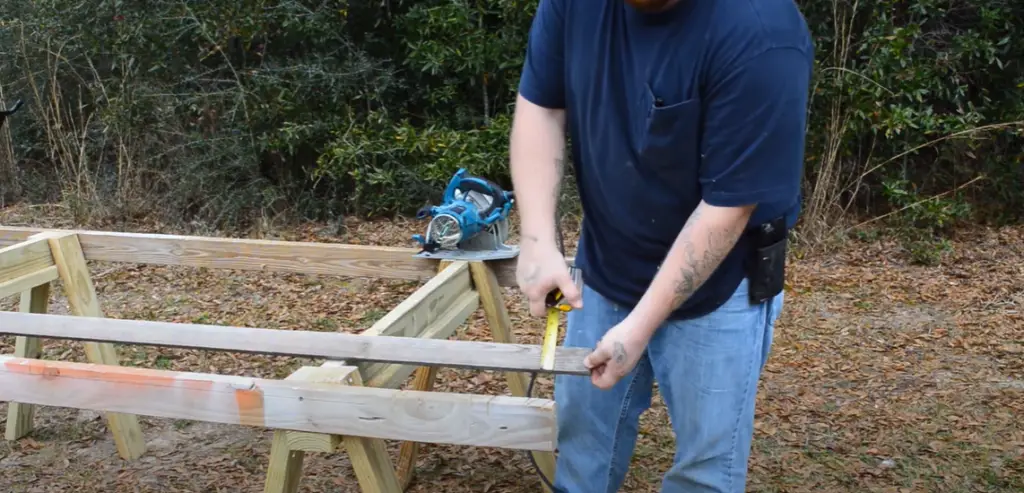
Hearing protection
In addition to eye protection, you should also have some form of hearing protection when operating a circular saw. The sound of the spinning blade can be very loud and can cause permanent hearing damage if the user doesn’t have some protective equipment. Hearing protection such as earplugs or noise-canceling headphones should always be used when using a circular saw.
Gloves
When working with a circular saw, it is important to wear gloves. The blade of the saw is very sharp and can easily cut through the skin if it comes into contact with it. Wearing gloves will protect your hands from the blade as well as any splinters or wood chips that may be generated. You should use gloves that are specifically designed for working with a circular saw. For example, insulated gloves can protect against electric shocks from the saw’s motor. Or gloves with reinforced palms and fingers can provide extra protection against the saw blade.
Work Clothes
When operating a circular saw, it is crucial to prioritize safety by wearing appropriate attire. Choose clothing that fits well and is not too loose, reducing the risk of it getting entangled in the blade. Opt for sturdy, close-toed shoes to safeguard your feet from potential flying debris. Furthermore, ensure that all jewelry and loose clothing items are removed before using the circular saw to eliminate any potential hazards. Taking these precautions will help create a safer working environment and minimize the chances of accidents or injuries.
Dust Mask
When using a circular saw, it is important to wear a dust mask or respirator to protect against dust and wood particles that can be inhaled while using the saw. These particles can cause irritation and damage to the lungs if breathed in, so it is important to take appropriate precautions when operating any type of power tool. Choose a dust mask or respirator that is rated for the job you are doing; some masks are better at filtering out smaller particles than others.
Using the proper protective gear and equipment when working with a circular saw is essential in ensuring safety and avoiding potential injuries or damage to the user. Wearing eye, hearing, hand, foot and respiratory protection can help create a safer working environment for the user and prevent accidents or harm from occurring while using a circular saw. Taking these precautions will ensure that you can work safely and efficiently with your circular saw [1].
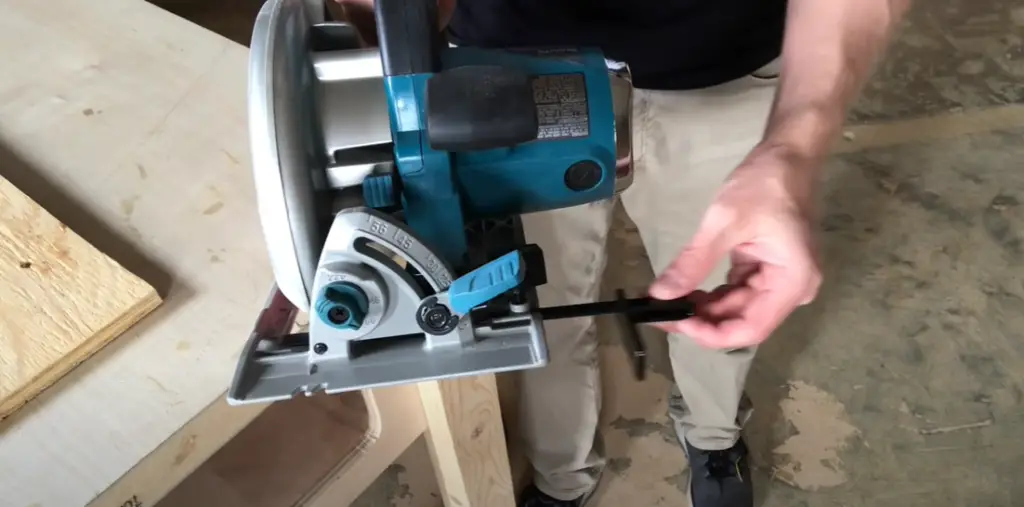
How to Make Rip Cuts with a Circular Saw
Start With an Accurate Cutline
When using a circular saw for rip cuts, achieving accuracy is crucial for a precise result. Begin by carefully marking an accurate cutline on the wood, ensuring its alignment with a straightedge to guarantee a perfectly straight line. If you’re working with multiple pieces of lumber, take the time to mark each one meticulously, enabling your finished project to exude a professional and polished appearance.
Set the Depth of Cut
To successfully execute a rip cut using a circular saw, it is crucial to properly set the blade’s depth. The depth adjustment should be carefully configured to be slightly lower than the thickness of the wood piece you are working with. This ensures that the blade does not cut through the material. Before proceeding, it is highly recommended to double-check and confirm that the depth is accurately set to avoid any potential mishaps during the cutting process. Taking these precautionary measures will contribute to a smooth and precise rip cut.
Clamp It Down
Before you start the cut, it’s important to secure the piece of wood firmly in place using clamps. By doing so, you ensure not only the stability of the material but also the safety of your hands, preventing them from getting too close to the blade. To ensure maximum stability during the cutting process, it is recommended to use multiple clamps to firmly and securely lock down the wood board, minimizing any unwanted movement. This additional step provides an extra layer of precaution, allowing you to work with confidence and peace of mind.
Make Your Cut
Now that the blade is correctly set at the desired depth and your wood is firmly clamped in place, you are ready to make your cut. Begin by carefully aligning the saw against the marked cutline before switching on the saw. Once it has been activated, guide it slowly along the line as you maintain a steady pace. Make sure to keep both hands firmly on the handles of the saw at all times to ensure proper control over its movements.
Rip cuts are a great way to add definition and structure to your DIY projects. With the help of these simple steps and lots of practice, you can master this technique in no time! Just remember that when using a circular saw for rip cuts, accuracy is paramount. Be sure to measure twice and cut once – it will ensure that your finished project looks perfect [2].
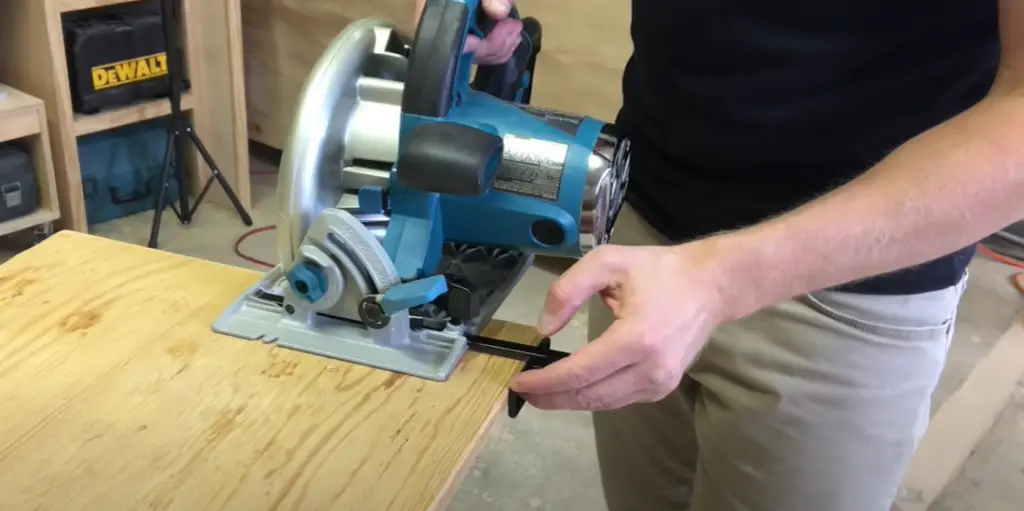
Tips to Improve Accuracy While Ripping
When it comes to making long, straight cuts in a piece of material, using a circular saw is the best way to go. However, it can also be tricky to use and require some practice in order to get consistent results. Here are some tips that will help you improve the accuracy of your work when using a circular saw for ripping:
- Start with a straight edge: The first step to getting an accurate cut is to make sure that the material you are cutting along is perfectly straight. Using a ruler or some other type of straight edge to guide your saw will help ensure that you get a nice, clean cut.
- Secure the material: Make sure your material is securely in place before beginning the cut so that it doesn’t move while you are cutting. This will help prevent the saw from wandering off course and ruining your cut.
- Use clamps: Clamping down the material to a workbench or other secure surface is another great way to keep it in place while you make your cuts.
- Adjust the depth gauge: Your circular saw should have a depth gauge that can be adjusted to the thickness of the material you are cutting. Making sure this is set correctly will help keep your cuts consistent and precise.
- Line up your sight lines: When cutting, it’s important to line up your sight lines properly. This makes it easier for you to guide the saw in a straight line and helps ensure that you get a nice, accurate cut.
- Sharpen the blade: Keeping your saw blade sharp is essential for getting clean cuts with minimal splintering. Make sure to regularly sharpen your blades as needed.
- Use a guide rail: If you are making a long cut, using a guide rail can help keep the saw going in a straight line and help you get a more precise cut.
- Take your time: Finally, don’t rush the process. A slower and more measured approach will ensure that you get an accurate cut with minimal mistakes or errors.
By following these tips, you should be able to improve the accuracy of your cutting when using a circular saw for ripping tasks. With some practice and patience, you will be able to get consistent and precise results every time [3].
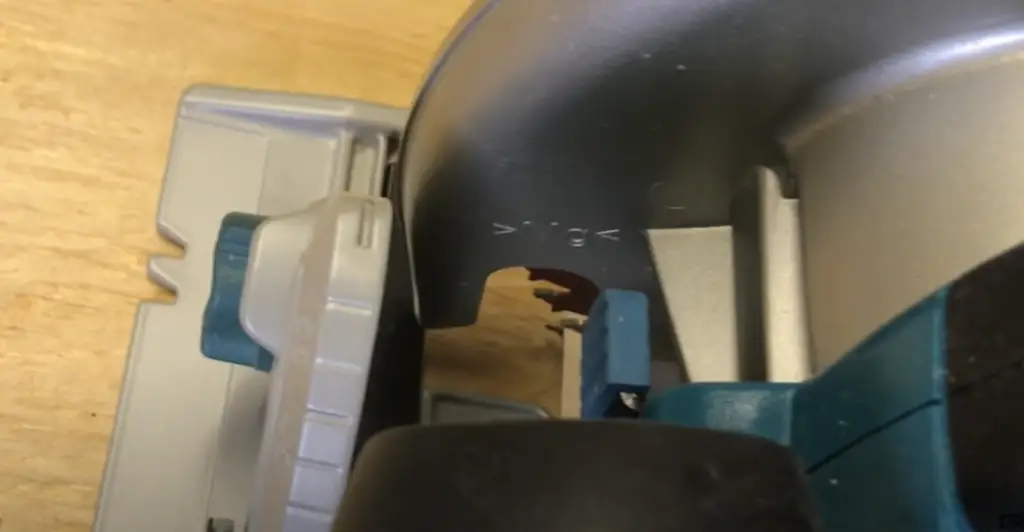
Choosing the Right Circular Saw for Your Needs
When it comes to choosing a circular saw for your projects, many factors should be taken into consideration before making a purchase. You’ll need to determine what type of materials you plan on cutting and what size of blade you’ll need to get the job done. Here are some tips that will help you choose the right circular saw for your needs:
- Blade size: The size of the blade is a crucial factor to consider when purchasing a circular saw. It determines the cutting capacity and efficiency of the tool. It is important to ensure that the blade is not only big enough to cut through the material you plan on using but also suitable for the specific type of cut you want to achieve. Choosing the right blade size will not only enhance the performance of your circular saw but also ensure accurate and clean cuts for your projects.
- Motor power: The motor power of the saw is a crucial factor to consider when choosing the right tool for your needs. It is essential to ensure that the saw has sufficient power to handle various cutting tasks with ease, delivering quick and efficient results. A powerful motor not only ensures smooth and precise cuts but also prevents the saw from bogging down or stalling out in the middle of a job, saving you time and frustration. So, when selecting a saw, make sure to prioritize adequate motor power for a hassle-free cutting experience.
- When considering weight, it is important to note that circular saws can vary in heaviness. Therefore, it is crucial to select a saw that not only meets your comfort requirements but is also easy to handle during your work tasks. By choosing a circular saw that strikes the right balance between comfort and ease of use, you can ensure a more pleasant and efficient working experience.
- When it comes to circular saws, there are various features to consider that can greatly enhance your cutting experience. Some models offer laser guides, which provide precision and accuracy, while others come with dust collection systems to keep your workspace clean and safe. Taking the time to think about the specific features you may need will ensure that you get the most out of your saw and achieve outstanding results in your projects.
By considering these factors, you should have no problem finding the right circular saw for your needs. With the right tool, you can make sure that every cut is precise and accurate, saving you time and money on your projects.
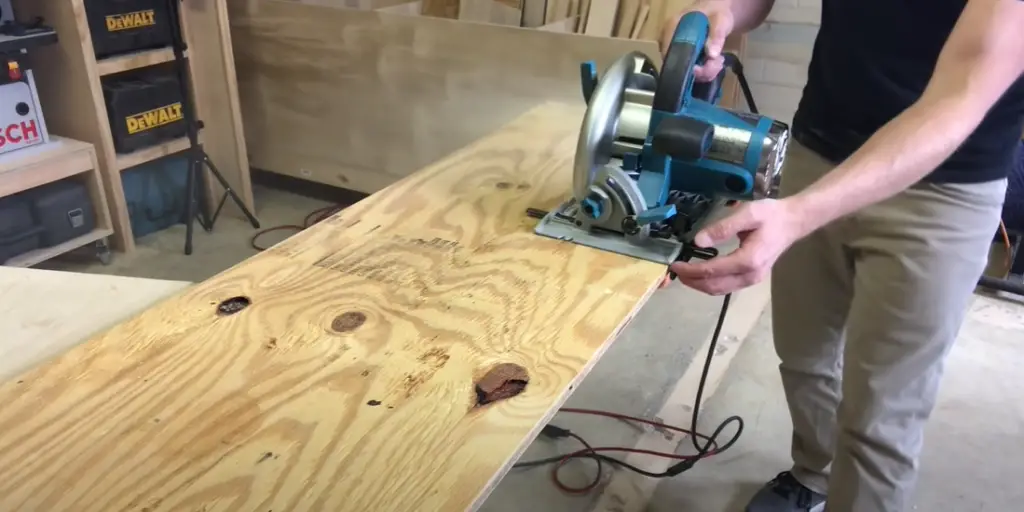
FAQ
What is the best tool to rip a board?
For optimal results when ripping a board, it is highly recommended that you use a high-quality circular saw. Circular saws are incredibly powerful and efficient tools that can effortlessly tackle your project with precision and speed. The key to achieving success with this remarkable tool lies in selecting the appropriate blade that suits your specific cutting needs and employing the proper technique to ensure the board remains unharmed throughout the process. By paying attention to these crucial details, you can confidently and flawlessly complete your woodworking tasks with utmost satisfaction.
What should I look for when buying a circular saw?
When searching for the right circular saw, there are various factors to consider. The type of material you plan on cutting is essential in determining what power and size of a circular saw you should obtain. Additionally, consider the number of features offered, such as depth-adjustment capabilities or bevel settings. It is also imperative to note that comfort and convenience are just as important, so look for a saw that has an ergonomically designed handle and a lightweight body. Furthermore, research the available blade options to obtain the most suitable one for your specific project.
How do I safely use a circular saw?
Before beginning any cutting task, always make sure to wear protective gear such as goggles and gloves. Additionally, check the saw’s blade to ensure it is sharp and undamaged. Start by placing your workpiece on a flat, stable surface and make sure that the material is firmly secured before beginning cutting operations. To begin sawing, slowly turn on the saw while keeping your feet at a safe distance from the blade. Make sure to observe proper form throughout the project, as this will greatly improve the accuracy and effectiveness of your cuts. Finally, when you are done cutting, turn off the saw and use a push stick to move away any remaining material or debris from the work area.
How do you rip a board without a bandsaw?
Ripping a board without the use of a bandsaw is possible with the help of a circular saw. All you need to do is adjust the saw’s blade guard and depth setting to make sure that it does not cut too deep into the material. Make sure to secure your workpiece firmly onto a flat, stable surface before starting any cutting operations. After that, slowly start cutting the material while maintaining proper form and posture. It is imperative to ensure that your hands are never near the blade during operation. When finished, turn off the saw and move any remaining material or debris away from the work area with a push stick.
Why should I use a circular saw?
Circular saws provide woodworkers with the ultimate tool to tackle their projects quickly and efficiently. They are incredibly powerful and versatile, making them suitable for a variety of cutting tasks. Additionally, thanks to their adjustable blade guard and bevel settings, you can easily adjust the saw’s depth according to your specific needs. Furthermore, it is light in weight and features an ergonomically designed handle for maximum comfort and convenience. With its wide variety of features and applications, the circular saw is undoubtedly an essential tool for any woodworker.
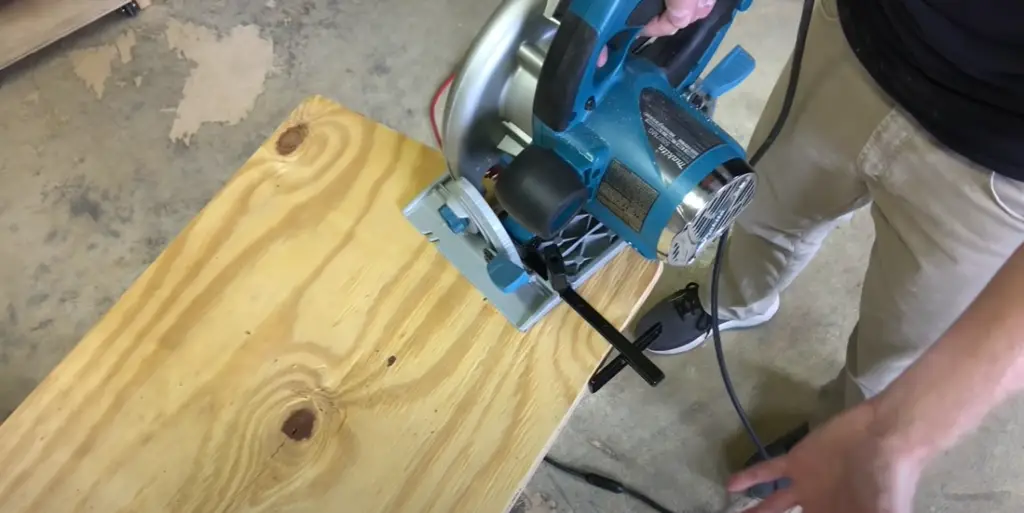
What are the cons of using a circular saw?
Although there are many advantages to using a circular saw, it does come with some drawbacks. The most significant downside is that these saws can cause kickback if not operated properly, which can potentially be dangerous. Additionally, circular saws do produce a large amount of dust and noise that could be hazardous to your health. It is also important to note that these tools require frequent maintenance and replacement of blades to keep them running optimally. Despite this, the benefits of using a circular saw far outweigh its disadvantages, making it an excellent tool for a variety of woodworking projects.
What tips and tricks should I know before using a circular saw?
When operating a circular saw, it is important to remember a few key points. First, always wear the appropriate safety gear such as goggles and gloves. Next, make sure to securely fasten your workpiece onto a flat, stable surface before cutting. Additionally, adjust the saw’s blade guard and depth settings to ensure that it does not cut too deep into the material. Finally, always remember to maintain proper form and posture during operation and move away any remaining material or debris from the work area with a push stick when finished. These helpful tips will enable you to operate your circular saw safely and efficiently.
What is the best blade for a circular saw?
When selecting a blade for your circular saw, it is essential to consider the material you are cutting as well as its thickness. For instance, if you are cutting hardwood or thick plywood, it is recommended that you use a high-tooth count blade with carbide tips. On the other hand, if you are cutting softwood or thinner materials, a low-tooth count blade works best. Additionally, certain blades are designed for specific applications such as ripping or crosscutting, so make sure to select the appropriate one according to your needs. With the right blade and proper technique, you can easily achieve optimal results with your circular saw.
How do you rip a 2×4 with a circular saw?
Ripping a 2×4 with a circular saw is an easy task, provided that you have the right blade and technique. To start, make sure to secure your workpiece on a stable surface before beginning any cutting operations. After that, adjust the saw’s blade guard and depth setting so it does not cut too deep into the material. Slowly start cutting the 2×4 while maintaining proper form and posture. Once finished, turn off the saw and use a push stick to move away any remaining material or debris from the work area. With these simple steps, you can easily rip a 2×4 with your circular saw.
What is the best angle for cutting wood with a circular saw?
The best angle for cutting wood with a circular saw varies depending on the type of cut you are making. For most applications such as crosscuts and rips, it is recommended to set your saw’s blade at an angle of between 0-45 degrees. However if you are making a bevel or miter cut, then it is best to adjust the blade angle to between 45-90 degrees. In any case, make sure to adjust the saw’s depth setting accordingly and use a push stick for added safety. With the right technique and tools, you can easily achieve the best results when cutting wood with your circular saw.
Useful Video: HOW TO RIP A BOARD QUICKLY WITH JUST YOUR CIRCULAR SAW
Conclusion Paragraph
Using a circular saw for ripping tasks can be tricky at first but with some practice and patience, it doesn’t have to be difficult. Following these tips will help you improve your accuracy and get consistent results every time. Additionally, taking the time to choose the right saw for your specific needs will ensure that you achieve outstanding results with minimal effort. With the right tools and techniques, you can make sure that every cut is clean and precise.
References:
- https://www.sawinery.net/how-to-rip-narrow-boards-with-a-circular-saw/
- https://bandsawblog.com/ripping-narrow-boards-with-circular-saws/
- https://www.tigerstop.com/mx/blog/improve-accuracy-optimize-straight-line-rip-saw/






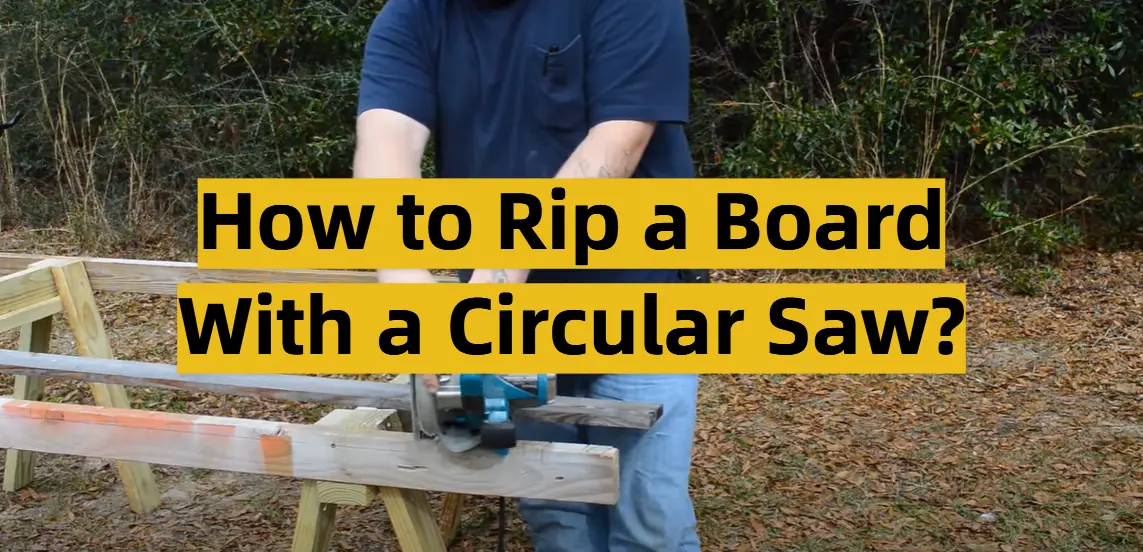








Leave a Reply